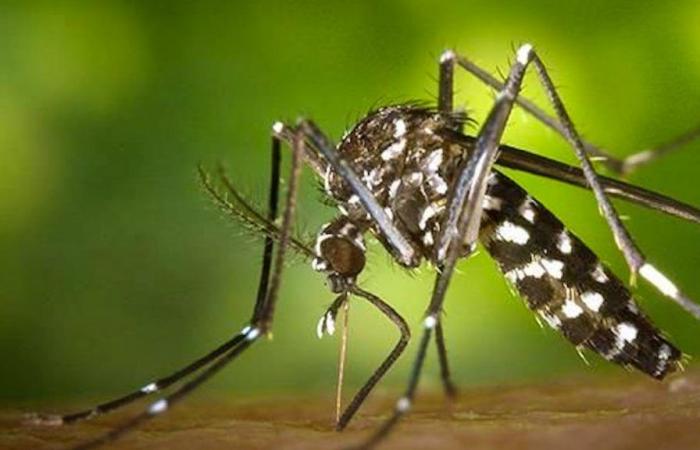The tiger mosquito is described as a very small mosquito with white and black stripes on its legs, a white line crossing its thorax and head.
CDC / JD Gathany
The tiger mosquito, vector of tropical diseases such as dengue, zika virus disease and chikungunya, is likely to settle in the canton of Neuchâtel due to climate change and its dispersion along transport routes, communicates the canton of Neuchâtel.
In recent months, the Cantonal Public Health Service (SCSP) has observed a slight increase in cases of dengue fever following travel to countries affected by this disease.
These cases do not constitute a public health problem as long as the tiger mosquito is not established in Neuchâtel. On the other hand, if this species becomes established and its population intensifies, a risk of a local epidemic resulting from an imported case is not excluded, as has been observed in Italy and the South of France.
In order to limit this health risk, the Canton of Neuchâtel invites the population to contribute to the elimination of potential breeding grounds for the tiger mosquito.
Watering cans, cups, containers…
This measure consists of eliminating its favorite spawning sites, i.e. places where small volumes of water stagnate in a rather urban environment such as watering cans, cups and containers of all kinds in gardens and on balconies, gutters not maintained houses or even holes in walls.
It should be noted that the tiger mosquito generally does not lay eggs in natural bodies of water such as ponds or ponds. Another effective prevention measure is reporting any presence of suspicious mosquitoes to the national platform www.moustiques-suisse.ch.
Some tips for recognizing the tiger mosquito: unlike native species, it is active during the day and very aggressive, being able to bite the same person several times. It is a very small mosquito (smaller than a quarter) with white and black stripes on its legs, a white line crossing its thorax and head.
Nesting traps set up
Alongside these prevention actions, monitoring campaigns are necessary. The Cantonal Wildlife, Forests and Nature Service (SFFN) carries out active surveillance by setting up nesting traps in strategic locations.
Since 2019, six traps have been placed in the municipal territory of La Tène in order to detect the possible presence of females ready to lay eggs. This action is carried out during the active period of the tiger mosquito, from May to September, and the traps are checked every two weeks.
Note that the insect will be considered established when its eggs have been recorded in the same trap during three consecutive surveys, two years in a row.
The measures taken in other cantons, which combine surveillance of strategic areas, rapid intervention and vigilance of the population, have demonstrated their effectiveness. The Confederation’s strategy, taken up by the Canton of Neuchâtel, consists of preventing the establishment or maintaining the population of tiger mosquitoes at a very low level in the event of establishment, in order to limit the risk of disease transmission.
The Canton of Neuchâtel also plans to meet with the municipalities this year with the aim of raising their awareness of this subject.
(Com/J.-Ch.C.)






